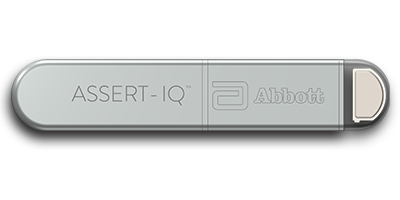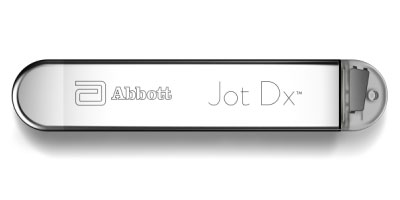Having pioneered the introduction of the world’s first Bluetooth®-enabled Insertable Cardiac Monitor (ICM), Abbott is leading innovation once more with the introduction of Assert-IQ™ ICM. With Assert-IQ ICM, you will be able to detect arrhythmias more accurately, see EGM details more clearly*, and gain additional insights to enable more informed decision making, all powered by state-of-the-art Bluetooth® technology and remote programming capabilities.** We have created an ICM that provides meaningful value in the areas that are most important to you and your clinic.1-4
Assert-IQ ICM
Assert-IQ™ ICM is the longest lasting ICM,† designed to provide true value with reduced false positives, simplified clinic workflows, and a reduced data burden.1-4, 6-10 This innovative ICM offers a long-lasting battery life despite its small size, making it an ideal device for patients to integrate into their daily lives seamlessly. All Abbott ICMs combine Bluetooth® wireless technology and an easy-to-use mobile app for fast and reliable remote monitoring for easier patient engagement.
Jot Dx ICM
The Jot Dx™ ICM is the first ICM system to let you toggle between viewing three Key Episodes*** and viewing all patient episodes. Reduce your data burden without sacrificing accuracy, or review all the data to catch those hard-to-detect arrhythmias.3 All Abbott ICMs combine Bluetooth® wireless technology and an easy-to-use mobile app for fast and reliable remote monitoring for easier patient engagement.5
Powering Hearts Beat to Beat
Sign up to hear about our technology, education opportunities, and more.
Read the Latest Blog Article
Stay up to date with recent news, product highlights, and case studies.
References
*Compared to predicate devices
**Available on DM5300/DM5500
*** Key Episodes is feature of Merlin.net™ PCN
† As of 12.31.22. Reveal LINQ‡ User Manual, Lux Dx‡ User Manual, Biomonitor III‡ User Manual, and Biomonitor IIIm‡ User Manual.
- Gopinathannair R, Lakkireddy D, Manyam H, et al. Improving the Specificity of Atrial Fibrillation and Tachycardia Detection in an Insertable Cardiac Monitor. Presented at Heart Rhythm Society (HRS); San Francisco, USA; 2022.
- Afzal MR, Gopinathannair R, Manyam H, et al. Development and Evaluation of a New Algorithm Enhancement to Improve Specificity of Pause Detection in an Insertable Cardiac Monitor. Presented at Heart Rhythm Society (HRS); San Francisco, USA; 2022.
- Gardner RS, Quartieri F, Betts TR, et al. Reducing the Electrogram Review Burden Imposed by Insertable Cardiac Monitors. J Cardiovascular Electrophysiology. 2022;33(4):741-750. doi:10.1111/jce.15397
- Abbott. Assert-IQ ICM User Manual.
- Piorkowsi C, Shaik N, Tilz R, et al. Early Real-World Adoption of Mobile Remote Monitoring Using the Confirm Rx Insertable Cardiac Monitor. Poster presented at Asia Pacific Heart Rhythm Society (APHRS); Taipei, Taiwan; 2018.
- Medtronic. REVEAL LINQ‡ LNQ11 Insertable Cardiac Monitor and Patient Assistant PA96000 Clinician Manual. Updated August 26, 2015. Accessed January 17, 2023. https://www.medtronic.com/content/dam/emanuals/crdm/CONTRIB_215651.pdf
- Medtronic. LINQ II‡ LNQ22 Insertable Cardiac Monitor Clinician Manual. Updated September 01, 2022. Accessed January 17, 2023. https://www.medtronic.com/content/dam/emanuals/crdm/M032283C001B_view.pdf
- Boston Scientific. User’s Manual, Lux-Dx‡ Insertable Cardiac Monitor System M301, 2925, 2935. Updated July 2020. Accessed January 17, 2023. https://www.bostonscientific.com/content/dam/Manuals/us/current-rev-en/92216689-002_LUX-Dx_UM_en_S.pdf
- Biotronik. Technical Manual BioMonitor III‡. Updated December 10, 2020. Accessed January 17, 2023. https://manuals.biotronik.com/emanuals-professionals/?country=US&product=ImplCardMon/BioMonitor3/BioMonitor3_US
- Biotronik. Technical Manual BioMonitor IIIm‡. Updated December 10, 2020. Accessed January 17, 2023. https://manuals.biotronik.com/emanuals-professionals/?country=US&product=ImplCardMon/BioMonitor3m/BioMonitor3m_US
Additional References
- EGM Burden Reduction in Jot Dx™ ICM, Technical Development Report System DOC 90805939 Rev A.
- Ip J, Jaffe B, Castellani M, Sheikh A, Castellani C, Ip R. Accuracy of Arrhythmia Detection in Implantable Cardiac Monitors: A Prospective Randomized Clinical Trial Comparing Reveal LINQ and Confirm Rx. Pacing & Clinical Electrophysiology. 2020;43(11):1344-1350. doi:10.1111/pace.14076
- Piorkowski C, Manyam H, Lakkireddy D, et al. Effectiveness and Performance of Confirm Rx SharpSense Technology: A Multi-center Retrospective Analysis. Presented at Asia Pacific Heart Rhythm Society (APHRS); Bangkok, Thailand; Oct 27-29, 2019.
™ Indicates a trademark of the Abbott group of companies.
‡ Indicates a third-party trademark, which is property of its respective owner.
Bluetooth and the Bluetooth logo are registered trademarks of Bluetooth SIG, Inc.
Important Safety Information
Rx Only
Brief Summary: Prior to using these devices, please review the Instructions for Use for a complete listing of indications, contraindications, warnings, precautions, potential adverse events and directions for use.
Indications for Use: Abbott ICMs are indicated for the monitoring and diagnostic evaluation of patients who experience unexplained symptoms that may be cardiac-related such as: dizziness, palpitations, chest pain, syncope, and shortness of breath, as well as patients who are at risk for cardiac arrhythmias such as bradycardia, tachycardia, and sinus pauses. Abbott ICMs are also indicated for patients who have been previously diagnosed with atrial fibrillation (AF) or who are susceptible to developing AF. Abbott ICMs are intended to be inserted subcutaneously in the left pectoral region, also described as the left anterior chest wall. Abbott ICMs have not been specifically tested for pediatric use.
Intended Use: Abbott ICMs are intended to help physicians and clinicians monitor, diagnose and document the heart rhythm in patients who are susceptible to cardiac arrhythmias and unexplained symptoms by detecting arrhythmias and transmitting data for review.
Contraindications: There are no known contraindications for the insertion of Abbott ICMs. However, the patient’s particular medical condition may dictate whether or not a subcutaneous, chronically inserted device can be tolerated.
Potential Adverse Events: Possible adverse events (in alphabetical order) associated with the device, include the following: allergic reaction, bleeding, chronic nerve damage, erosion, excessive fibrotic tissue growth, extrusion, formation of hematomas or cysts, infection, keloid formation and migration.
Refer to the User’s Manual for detailed indications for use, contraindications, warnings, precautions and potential adverse events.
An Abbott mobile transmitter is available for patients without their own compatible mobile device.
MAT-2010519 v9.0



